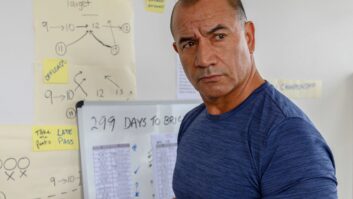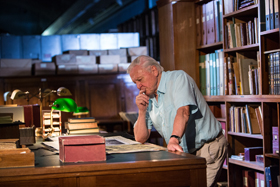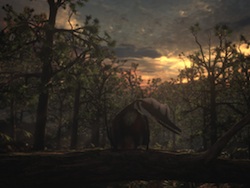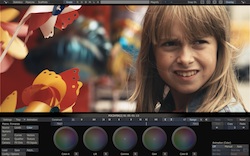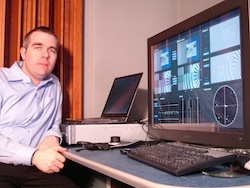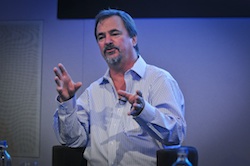
IBC’s masterclass on comparing the costs and impacts of both native 3D shooting and 2D conversion was a high calibre tutorial that ended with the chilling warning, “3D is here to stay unless we kill again”, writes George Jarrett.
Speakers David Stump ASC (pictured) and Jonathan Banta have been working together on the conversion of the 11.11.11 release Immortals, but went out of their way to use their comparisons to paint conversion and native shooting as different tools.
Stump handled the summary of stereo native shooting. “It is heavy on set cost and technical problems, but resolves to natural stereo,” he said. “Native complicates post, but improves your pipeline. It has a better reputation for the moment, which makes for better box office.
“If stereo native is broken, it is hard to fix,” he added. “It slows down your production to gain better results, and it is expensive.”
Banta summarised 2D conversion. “It does not slow down on-set production, and it can be cost-effective. It is labour intensive, but procedures are fixed. Conversion is an animated movie drawn by hand. And that adds cost to your budget,” he said.
“Conversion is subjective and needs more time, otherwise it will alienate the audience and cost box office,” he added. “Conversion is also prone to error, and crucified by press and public when done poorly.”
The way forward, Stump concluded, is to use hybrid methods, “as each challenge is better solved by the proper application of the toolset”.
Asked if the time will come when producers choose to shoot natively and conversion drops away, Stump said: “I would say ‘no’ because there are infinite numbers and kinds of directors, some who will embrace shooting natively in 3D and some who will not, as [with Tarsem Singh for Immortals]. And it’s a different kind of movie, a different style of movie. Unless the technology of acquisition changes, there is room for both.”
Wrapping up, Stump added: “I wish everyone in Hollywood would stop trying to be a prophet. As long as the studios make money from 3D productions, and as long as audiences appreciate what they see, it is here to stay in both guises.”
www.ibc.org/conferenceprogramme IBC’s masterclass on comparing the costs and impacts of both native 3D shooting and 2D conversion was a high calibre tutorial that ended with the chilling warning, “3D is here to stay unless we kill again”, writes George Jarrett.
Speakers David Stump ASC (pictured) and Jonathan Banta have been working together on the conversion of the 11.11.11 release Immortals, but went out of their way to use their comparisons to paint conversion and native shooting as different tools.
Stump handled the summary of stereo native shooting. “It is heavy on set cost and technical problems, but resolves to natural stereo,” he said. “Native complicates post, but improves your pipeline. It has a better reputation for the moment, which makes for better box office.
“If stereo native is broken, it is hard to fix,” he added. “It slows down your production to gain better results, and it is expensive.”
Banta summarised 2D conversion. “It does not slow down on-set production, and it can be cost-effective. It is labour intensive, but procedures are fixed. Conversion is an animated movie drawn by hand. And that adds cost to your budget,” he said.
“Conversion is subjective and needs more time, otherwise it will alienate the audience and cost box office,” he added. “Conversion is also prone to error, and crucified by press and public when done poorly.”
The way forward, Stump concluded, is to use hybrid methods, “as each challenge is better solved by the proper application of the toolset”.
Asked if the time will come when producers choose to shoot natively and conversion drops away, Stump said: “I would say ‘no’ because there are infinite numbers and kinds of directors, some who will embrace shooting natively in 3D and some who will not, as [with Tarsem Singh for Immortals]. And it’s a different kind of movie, a different style of movie. Unless the technology of acquisition changes, there is room for both.”
Wrapping up, Stump added: “I wish everyone in Hollywood would stop trying to be a prophet. As long as the studios make money from 3D productions, and as long as audiences appreciate what they see, it is here to stay in both guises.”
